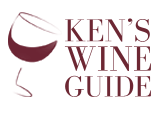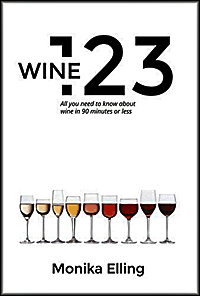By Julia Hoggins
If you’re looking for something to read about wine in a short period of time, I would highly recommend Monika Elling’s Wine 123. Whether you're just starting to like wine or are an experienced taster, this book offers a brief insight on the basics of understanding how to choose and differentiate wines. It can be overwhelming to select a bottle or even a glass of wine no matter what the occasion, so familiarizing yourself with the basics is important.
The first step is noticing the weight of wine, or “WOW” as Monika Elling calls it in her book. Color is essentially the fastest way to know the difference between heavy, medium, or light wines. This method can be used for comparing both red and white wines. The alcohol levels also contribute to the WOW scale. The darker the wine, the more weight it has and vice versa. For example, a light white would be a Pinot Grigio, but a heavy red would be a dark Cabernet Sauvignon.
If you're wondering what wines to pair with specific dishes, Elling also gives you a breakdown of how to go about pairing. Traditionally, darker reds are good with dark meats like steak, and a nice white Chardonnay goes well with a light fish or chicken.
True wine professionals are open to trying new types of wine even if they have favorites. Professionals classify wines under two categories: Old World vs. New World. Old World wines are produced in European regions, whereas New World wines are produced in North and South America, Australia, New Zealand and South Africa. In the modern era, most New World high quality wines are from California. New World wines are fruitier and have a higher alcohol content, and they can be enjoyed with meals but also on their own. Whereas, Old World wines tend to accompany a meal.
Monika Elling also reveals a corked versus screw cap bottle of wine. The problem that occasionally arises from corked wine is a fungus called Trichloroanisole (TCA). It’s reportedly found in 3-10% of naturally corked bottles creating a very undesirable musty aroma, and potentially taints the wines. As a result, many winemakers are now turning to screw-caps. There isn’t currently enough information on the age ability of screw-caped wines, but wineries are in the process of studying it. With a screw cap, customers are assured to get the full value of the wine.
Another fact that will enhance your knowledge about wine is the difference between Champagne and Sparkling Wine. Champagne is only considered “Champagne” if it comes from the Champagne wine region of France. Any other wine with bubbles is referred to as Sparkling Wine. You also might not know that Champagne is typically made from two red grapes and one white: Pinot Noir, Pinot Meunier and Chardonnay.
Did you know you can have wine for dessert? In Tokaj, Hungary in the early 1500s, dessert wine was discovered by monks who found shriveled grapes on the vine and found that the delayed harvest resulted in an intense sweetness to the wine. Delaying the harvest allows the grapes to be infected by Noble Rot, “Botrytis,” and the dried-out result contains a high concentration of natural sugars, giving the wine a sweet taste.
Whether your looking for a nice sweet dessert wine, or a perfect blend of food and wine to please your taste buds, Wine 123 is the perfect book to read in 90 minutes or less that will tell you all you need to know about the basics of wine. From history, to wine selection, pairing, and how to look like a “pro” while swirling and holding your glass, this book covers it all.
Cheers! – Julia Hoggins

